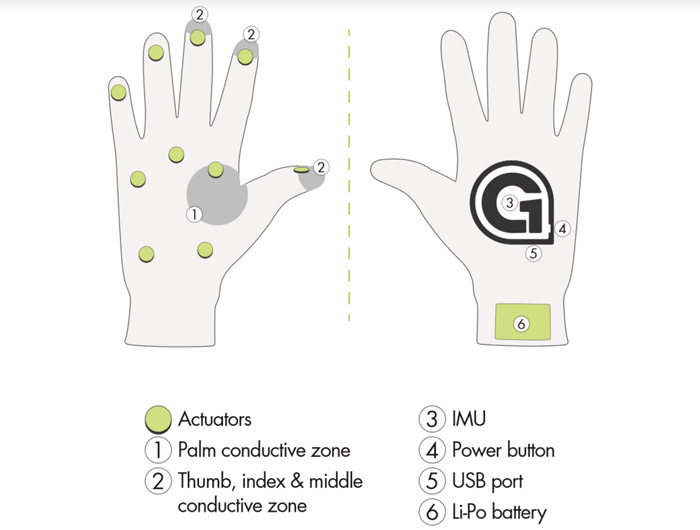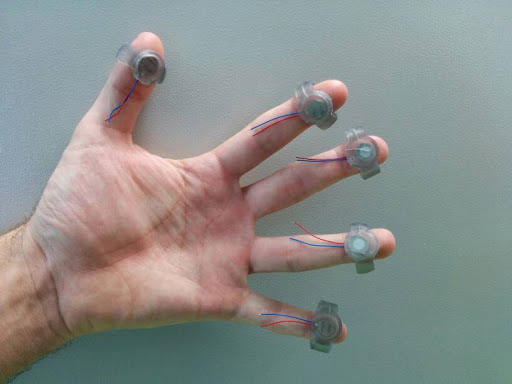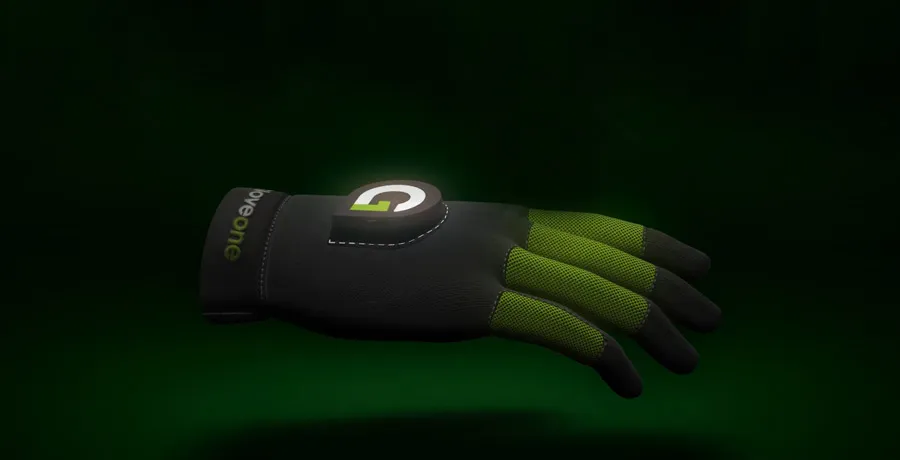I tilt my palm up and stick my hand out into the virtual rain. It’s something that I’ve done before, using Leap Motion’s finger tracking but this time it was very different. This time I felt something.
I recently had the opportunity to demo NeuroDigital Technologies’ GloveOne prototype, a haptic feedback glove input device designed for virtual reality. The glove uses a set of ten actuators, placed strategically on the fingertips and on areas of the palm. These actuators emit different degrees of pulse sensations which can be controlled very finely to mimic the sensations of pressing against a button, plucking the strings of a guitar, and of course feeling drops of rain on your out stretched hand.

The effect is far from perfect, there are certain sensations that work better than others, for example the rain was extremely effective but simulations of weight for example are still a little on the lackluster side. One of the things that was of particular interest was the feedback in a gesture based UI setting.
Example of a Holographic UI with Leap Motion
Pressing buttons, for example, can be difficult in VR because there is no haptic feedback telling the brain that the finger is pressing against something. GloveOne’s finger vibrations make these actions a lot more comfortable and natural feeling – but again they aren’t perfect, and the actuators don’t push with enough force to make you feel that you really have a barrier you are pressing against. For a holographic UI though this might feel more realistic.
According to Castillo, the company plans to add more and more powerful actuators to the glove between now and shipping. This should help increase not only the variety of the sensations but the strength of them as well. I demoed a similar technology in a much different form factor, Miraisens, at GDC and the sensation there was fairly impressive. It would be interesting to see a similar level of strength in a glove form factor.
But that is just the start of the improvements he has planned.
Currently the GloveOne has a single embedded 9 degree of freedom (DOF) IMU on the prototype which works in conjunction with a Leap Motion or Intel’s RealSense for hand and finger tracking. NeuroDigital plans to change up its strategy and embed a 3 DOF IMU into each finger as well as the 9 DOF IMU on the back of the glove. This combined with simple optical tracking Castillo says, will allow for more precision.

Speaking further on tracking he says NeuroDigital is working on integration with the Samsung GearVR using the passthrough camera to track the “hand blob” in conjunction with the IMUs. This would be an interesting route, especially with the haptic simulations from the glove.
But what about desktop? Castillo says NeuroDigital is looking to add Lighthouse tracking to the GloveOne. If NeuroDigital is able to follow through on this, they would be the first third party input device to utilize Valve’s new tracking standard, which CEO Gabe Newell says they want to be “like the USB” in its openness. This is a potentially promising development for the project which enters the final stretch of its Kickstarter campaign this week.
Speaking of developments, NeuroDigital has released the GloveOne’s SDK to developers so that they can start playing around with how to integrate haptics into their experiences. According to Castillo, GloveOne will come with a toolkit to help developers create custom sensations for different objects. Having a library like this will make life easier as developers try to write in the different sensations of various types of interactable objects throughout their games.
If NeuroDigital can deliver on these lofty promises the GloveOne could be an impressive addition to a high-end VR experience. Speaking with Thomas Zimmerman, one of virtual reality’s forefathers and one of the people behind the DataGlove, about GloveOne he seems optimistic that this type of approach is good for virtual reality. “Any feedback is better than none,” he says, “this was particularly noticeable when we tried to play air guitar with the DataGlove… without the tactical feedback of the fretboard, it was really hard to play intentional notes.” Having played air guitar in VR with GloveOne’s haptics both on and off, I can attest to the difference. It’s price ($200 per hand) will likely keep it out of the hands of many casual users, but for those looking for the most immersive experiences possible, the GloveOne may be a good place to start.
UPDATE (7/3/15 @ 2:25PM PST): The GloveOne just passed its $150k Kickstarter goal GloveOne currently stands at around $49k short of it’s $150k Kickstarter goal with only 6 days to go, so those interested in bringing getting their own Lighthouse tracked gloves to high-end VR experiences should definitely back it now.




























